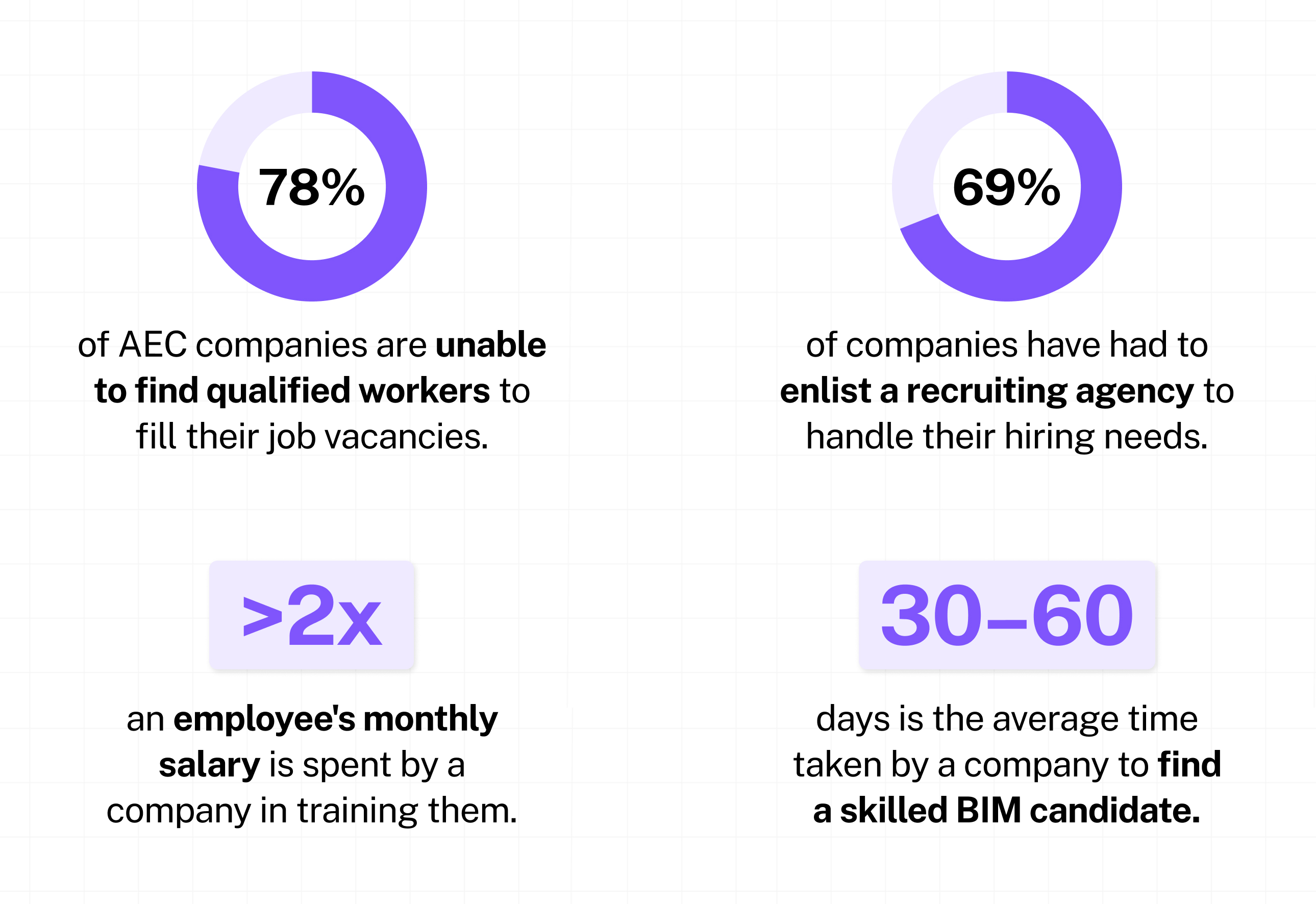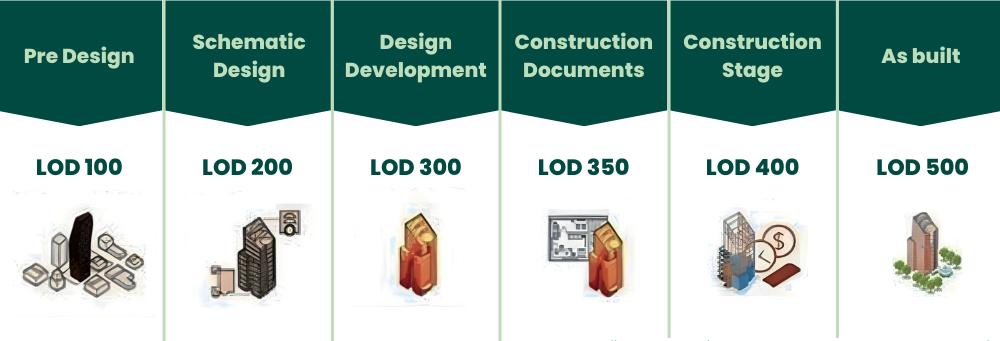The Rising Cost of Hiring for BIM Roles and How to Reduce It

Table of Contents
With digitalisation engulfing the Architecture, Engineering, Construction and Operations (AECO) industry at breakneck speed today, companies all over the world are scampering towards complete implementation of Building Information Modelling (BIM) for all of their projects. The process has already become imperative for companies to remain relevant to the industry and continue providing value to their clients. As of August 2022, BIM has achieved an adoption rate of 70% globally, as per a new report by McKinsey.
However, even as the popularity of BIM continues to soar, it presents new challenges for AECO employers. The biggest hurdle of all has been found to be the humongous cost involved in recruiting skilled candidates for BIM roles. Let’s find out what these costs are and how they can be minimised.
Costs Involved in Hiring for BIM Roles
1. The cost of hunting for skilled BIM talent
It is a truth well known that architecture and engineering colleges fail to equip their graduates with real-world, industry-relevant knowledge. This means that BIM talent is highly specialised and 78% of construction companies are unable to find qualified workers to fill their open job vacancies. On average, it takes a company about 30–60 days to make a hire for BIM and related roles.
2. The cost of enlisting a recruitment agency
There are no consolidated career platforms to find and hire skilled BIM talent. This leads to complications in hiring the right people, such as misjudgement of candidates’ CVs and work experience. As a result of this, 69% of companies have had to enlist the services of a recruiting or executive search firm to handle their hiring needs during the past two years.
3. The cost of training employees in BIM processes
Once hired, a candidate often has to undergo an intensive, months-long training program to become familiar with in-house BIM tools and processes before they can begin contributing to the company’s projects in a meaningful way. This BIM training alone can cost a firm nearly twice an employee’s monthly salary, which is a difficult expense to bear. The total cost of BIM training is INR 6 lakh per employee in India and USD 20-25K per employee in the USA, UK, Canada and Europe.
4. The cost of employee attrition
People join BIM-based roles, but quit just as rapidly. A number of professionals look to join companies only to learn industry processes, and simply move onto the next company after gaining the requisite knowledge. Another category of employees has a misconception of what BIM roles truly involve; they find the pace of BIM work too tough, and quit. By this time, a company has already invested considerable resources in hiring and nurturing these employees. Needless to say, these short-term associations hurt the company’s progress.

All of these factors lead to companies struggling to improve their productivity and stay ahead of the digital adoption and innovation curve in AECO. So how can companies’ management and HR departments fix this problem?
A recent publication by Hill International claimed that a major reason for companies’ ongoing struggle with BIM recruitment is their own tendency to consider only a limited number of degrees and educational backgrounds year after year. Instead of relying on “the way it’s always been done”, it would be more beneficial for companies to consider new areas for recruitment; broaden their nets by looking at more skill-based certifications and technical experience.
If a company does choose to broaden their nets, a potential catch could be the graduates of Novatr’s BIM Professional Course. As a learning platform dedicated to bridging the talent gap in AECO, Novatr boasts tech-focussed skill development, which has successfully yielded multiple cohorts of professionals ready to dive head first into new BIM opportunities.
Industry Rates for BIM Services, Rate Types & Average Cost
Average Costs to Hire a BIM Consultant:
- Top Earners- $43/hr
- 75th Percentile - $43/hr
- Average- $39/hr
- 25th Percentile- $33/hr
However, many other factors could either fluctuate this price significantly, such as the experience of the consultant, the delivery timeline and the difficulty level.
Service cost per square foot
- White Model $0.30
- Material Model $0.60
- Ornament Model $0.60
- BIM Model $0.90
Turnaround Time Cost per Source Document
- 3 Days $350
- 5 Days $245
- 10 Days $195
- 4 – 6 Weeks $140
How to Minimise Hiring Costs for BIM Roles
1. Get uninterrupted access to a focused BIM talent pool
Hundreds of professionals graduate from Novatr’s BIM Professional Course every alternate month. This ensures a continuously replenishing talent pool for companies to recruit from. Novatr facilitates this hiring at zero charge. We build and enable systems that accelerate the process of training in BIM, hiring for BIM, and creating a digitised and empowered AECO landscape.
2. Eliminate the need for post-recruitment BIM training
Novatr’s learners are trained by BIM experts who work at the most prestigious AECO firms globally, including ZHA, BIG, RSP, UNS Studio and Arup. They’re trained as per an industry-relevant curriculum that includes 7+ BIM software and digital workflows. In addition, the course graduates develop hands-on experience working on an international, RIBA-structured project based in the US, Portugal, or Hong Kong. This ensures a detailed knowledge of real-world processes.
Aslo Read: Architect vs. BIM Architect: A Comparative Guide to Careers & Salaries
3. Make sure the candidates come to you with pre-vetted skills
A study by the Harvard Business Review found that 80% of employee turnover is due to bad hiring decisions, and 45% of bad hires are attributed to a lack of process. To avoid this and facilitate informed hiring decisions, Novatr provides its hiring partners with an in-depth skill map and transparent report of the candidates’ competencies.
4. Ensure the candidates are committed to pursuing a BIM career
After 6 months of rigorous training, Novatr’s graduates enter the industry fully ready to actively contribute to BIM implementation in AECO across projects of varying scales. They take this step as they are not only fully committed to developing a career in BIM but also driven to lead innovation in their workplaces. The problems of flaky candidates and misjudged CVs are solved by a consolidated pool of interested and extremely invested candidates.
Conclusion
The surge in demand for BIM roles in the industry has brought about significant hiring challenges for employers. The costs associated with recruiting BIM-skilled talent, from the extensive search to training programs, have proven to be substantial hurdles. However, by understanding the intricacies of these costs, companies can implement strategies to minimise them.
A fundamental shift in recruitment processes is key to minimising the costs involved in BIM roles. If you are currently looking for trained and experienced candidates to accelerate your firm’s growth and workflow, we highly recommend partnering with Novatr for all your hiring needs.

 Thanks for connecting!
Thanks for connecting!


.png)






